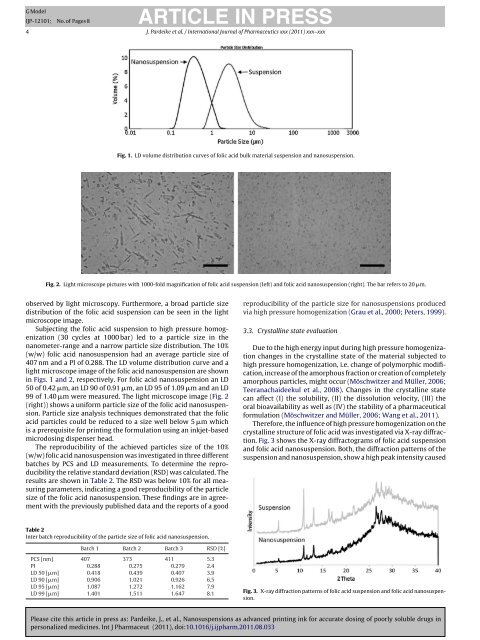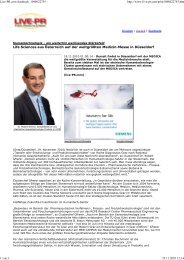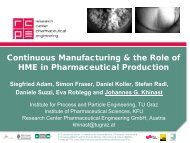Nanosuspensions as advanced printing ink for accurate ... - RCPE
Nanosuspensions as advanced printing ink for accurate ... - RCPE
Nanosuspensions as advanced printing ink for accurate ... - RCPE
You also want an ePaper? Increase the reach of your titles
YUMPU automatically turns print PDFs into web optimized ePapers that Google loves.
ARTICLE IN PRESS<br />
G Model<br />
IJP-12101; No. of Pages 8<br />
4 J. Pardeike et al. / International Journal of Pharmaceutics xxx (2011) xxx– xxx<br />
Fig. 1. LD volume distribution curves of folic acid bulk material suspension and nanosuspension.<br />
Fig. 2. Light microscope pictures with 1000-fold magnification of folic acid suspension (left) and folic acid nanosuspension (right). The bar refers to 20 �m.<br />
observed by light microscopy. Furthermore, a broad particle size<br />
distribution of the folic acid suspension can be seen in the light<br />
microscope image.<br />
Subjecting the folic acid suspension to high pressure homogenization<br />
(30 cycles at 1000 bar) led to a particle size in the<br />
nanometer-range and a narrow particle size distribution. The 10%<br />
(w/w) folic acid nanosuspension had an average particle size of<br />
407 nm and a PI of 0.288. The LD volume distribution curve and a<br />
light microscope image of the folic acid nanosuspension are shown<br />
in Figs. 1 and 2, respectively. For folic acid nanosuspension an LD<br />
50 of 0.42 �m, an LD 90 of 0.91 �m, an LD 95 of 1.09 �m and an LD<br />
99 of 1.40 �m were me<strong>as</strong>ured. The light microscope image (Fig. 2<br />
(right)) shows a uni<strong>for</strong>m particle size of the folic acid nanosuspension.<br />
Particle size analysis techniques demonstrated that the folic<br />
acid particles could be reduced to a size well below 5 �m which<br />
is a prerequisite <strong>for</strong> <strong>printing</strong> the <strong>for</strong>mulation using an <strong>ink</strong>jet-b<strong>as</strong>ed<br />
microdosing dispenser head.<br />
The reproducibility of the achieved particles size of the 10%<br />
(w/w) folic acid nanosuspension w<strong>as</strong> investigated in three different<br />
batches by PCS and LD me<strong>as</strong>urements. To determine the reproducibility<br />
the relative standard deviation (RSD) w<strong>as</strong> calculated. The<br />
results are shown in Table 2. The RSD w<strong>as</strong> below 10% <strong>for</strong> all me<strong>as</strong>uring<br />
parameters, indicating a good reproducibility of the particle<br />
size of the folic acid nanosuspension. These findings are in agreement<br />
with the previously published data and the reports of a good<br />
Table 2<br />
Inter batch reproducibility of the particle size of folic acid nanosuspension.<br />
Batch 1 Batch 2 Batch 3 RSD [%]<br />
PCS [nm] 407 373 411 5.3<br />
PI 0.288 0.275 0.279 2.4<br />
LD 50 [�m] 0.418 0.439 0.407 3.9<br />
LD 90 [�m] 0.906 1.021 0.926 6.5<br />
LD 95 [�m] 1.087 1.272 1.162 7.9<br />
LD 99 [�m] 1.401 1.511 1.647 8.1<br />
reproducibility of the particle size <strong>for</strong> nanosuspensions produced<br />
via high pressure homogenization (Grau et al., 2000; Peters, 1999).<br />
3.3. Crystalline state evaluation<br />
Due to the high energy input during high pressure homogenization<br />
changes in the crystalline state of the material subjected to<br />
high pressure homogenization, i.e. change of polymorphic modification,<br />
incre<strong>as</strong>e of the amorphous fraction or creation of completely<br />
amorphous particles, might occur (Möschwitzer and Müller, 2006;<br />
Teeranachaideekul et al., 2008). Changes in the crystalline state<br />
can affect (I) the solubility, (II) the dissolution velocity, (III) the<br />
oral bioavailability <strong>as</strong> well <strong>as</strong> (IV) the stability of a pharmaceutical<br />
<strong>for</strong>mulation (Möschwitzer and Müller, 2006; Wang et al., 2011).<br />
There<strong>for</strong>e, the influence of high pressure homogenization on the<br />
crystalline structure of folic acid w<strong>as</strong> investigated via X-ray diffraction.<br />
Fig. 3 shows the X-ray diffractograms of folic acid suspension<br />
and folic acid nanosuspension. Both, the diffraction patterns of the<br />
suspension and nanosuspension, show a high peak intensity caused<br />
Fig. 3. X-ray diffraction patterns of folic acid suspension and folic acid nanosuspension.<br />
Ple<strong>as</strong>e cite this article in press <strong>as</strong>: Pardeike, J., et al., <strong>Nanosuspensions</strong> <strong>as</strong> <strong>advanced</strong> <strong>printing</strong> <strong>ink</strong> <strong>for</strong> <strong>accurate</strong> dosing of poorly soluble drugs in<br />
personalized medicines. Int J Pharmaceut (2011), doi:10.1016/j.ijpharm.2011.08.033







